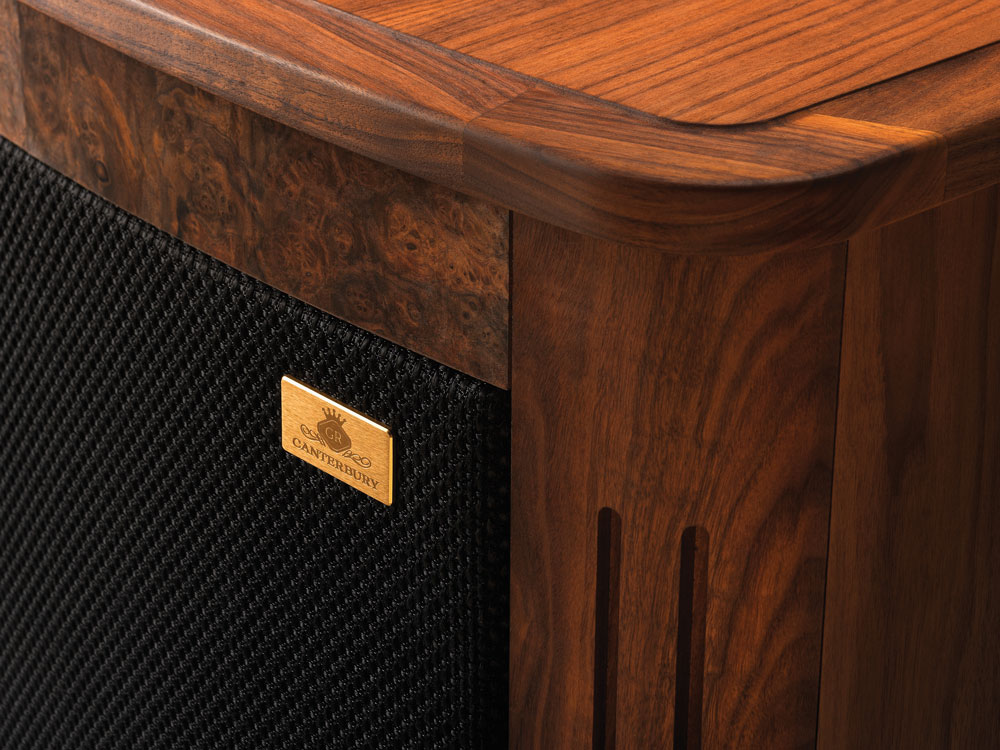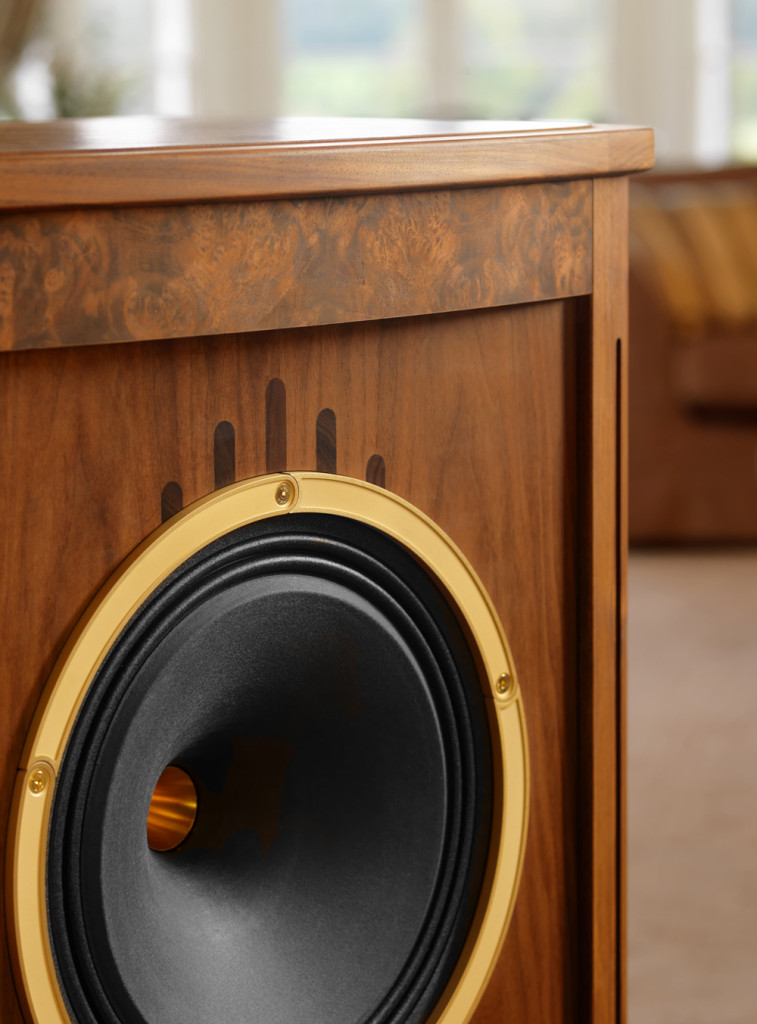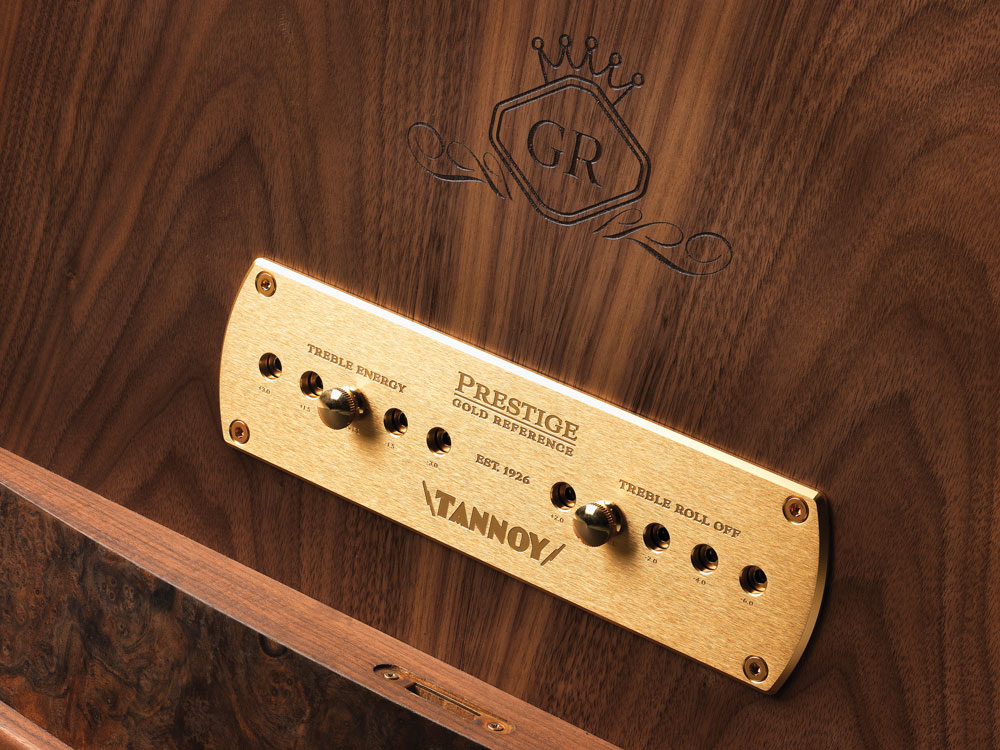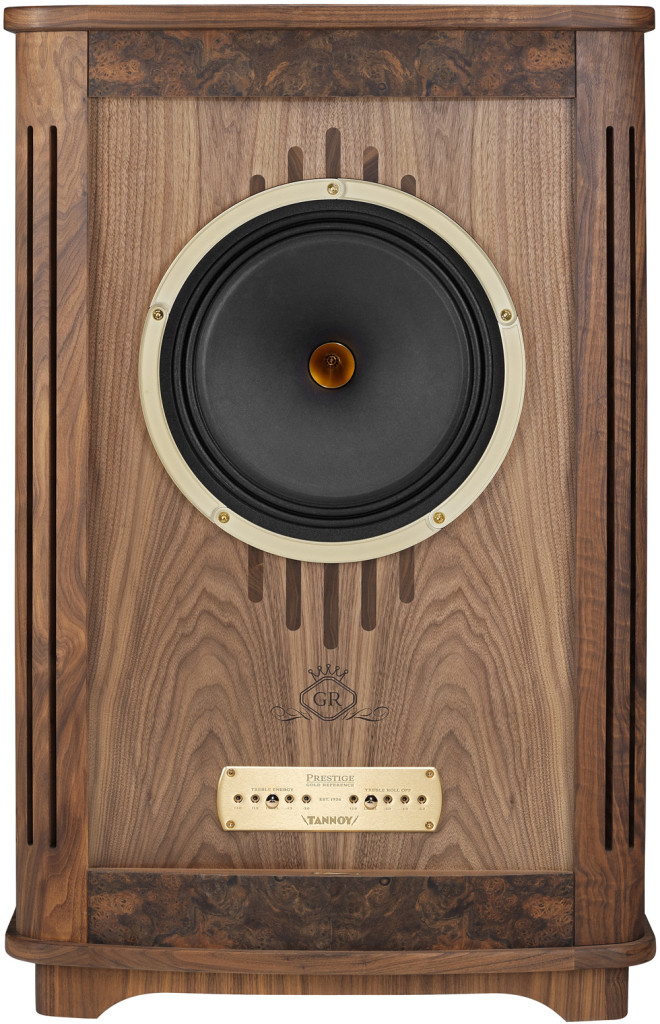Bass
As you might expect, speakers with 15-inch cones project a lot of bass power if driven with appropriate electronics. The Pass Labs Xs 300 and the Electrocompaniet Nemo and Nada were seriously “appropriate”, and the effect is a tonally tight yet physically expanding bass penumbra that hits the listener with force. (More on the “penumbra” later.) For kicks, at one point I connected the Tannoy Prestige Canterbury GR to an old, inexpensive 80-watt Denon receiver just to see the difference. There was clearly less impact, but the Denon had no difficulty in driving the Canterbury in a manner which was quite pleasing. Tannoy’s spec indicates use of amps with 20-300 watts of output, and that is clearly an advantage to any purchaser. You can use low-power tube electronics and experiment with higher power options as you progress on the upgrade path.
Though it sports a 15-inch woofer and is a ported design with a traditional box cabinet, there was no trace of “one-note” emphasis that some speakers that incorporate these elements exhibit. Moreover, there is no energy loss in the lower midrange/upper bass that is characteristic of some floorstanders. The effect of this in some floorstanders is a sense of discontinuity between the bass and midrange with music that has significant content in the 100-200 Hz range. No such issue exists with the Tannoy Prestige Canterbury GR, and the frequency response was subjectively flat throughout the entire audible frequency range, including the difficult transition between upper bass and lower midrange.
I played a wide range of bass-heavy music for this portion of the review, including organ music and Bela Fleck’s Flight of the Cosmic Hippo, and I was very pleased by the results. In general, I personally prefer the more robust bass sound that one gets from vented designs, and the Canterbury was no exception to that general rule. I find that most sealed box speakers’ bass is too tightly controlled and does not sound to me like bass does in a live performance. There are, of course, numerous exceptions to this generalization, just as it is inaccurate to say that all vented designs sound bloated. Nonetheless, the Tannoy Prestige Canterbury GR clearly fall into the “robust” bass camp without losing any meaningful bass articulation. If the note was there, the Canterbury reproduced it cleanly and with appropriate weight. For comparison, the twice-as-expensive Giyas are a bit tighter and a bit more extended, while the tonality is similar to that exhibited by the one-tenth-as-expensive Sonus Fabre Verere 3.0, just with a lot more force and bass extension.
Midrange, Treble and Integration With the Bass
I’m addressing the Tannoy Prestige Canterbury GR’s midrange and treble in the same section of this article because, well, they’re produced by the same horn in a full-range speaker with a 2-way design. I will also discuss the integration of the treble and midrange with the bass.
The height of the mid-section of the Dual Concentric caught my attention early in the review. I find that even with speakers that have wide radiation patterns, it is best to have the tweeters at ear level. My listening chairs are such that the height of the center of the Dual Concentric was below ear level. Though I found that this could be corrected by moving the listening chair further back, that did not work well with the dimensions of my listening room, which is why I opted for the slight upward tilt that I described earlier in this article. You should definitely consider elevating the Canterbury when setting it up. Before tilting the front up I had the sense that the top of the soundstage was cut off, as though the ceiling was lowered. I also obtained better treble tonality and imaging with the upward tilt, and I would expect that a slight elevation of the speakers would be the best solution for most listeners.
As I previously described, the Dual Concentric, like other transducers, projects an expanding sound wave into the room. The difference is that the sound waves that emanate from the high frequency unit are embedded within the sound wave emanating from the low frequency unit. Contrast this with the overlapping sound waves that emanate from other 2, 3 or 4-way designs. You have the bass units set in the low position, midrange in the middle position, and treble units typically in the highest position. Each separate wave must spread out and eventually intersect at the listening position. The Dual Concentric, on the other hand projects outward from the speaker in a single expanding wave. Visualize an umbrella viewed from the tops as it slowly opens to full size.
The term “penumbra” comes from the description of shadows, particularly those cast by the earth and moon. In law, however, penumbra is used to describe an expansion of powers or rights beyond their strict meaning to include the necessary implications of that strict meaning. As it relates to the Tannoy Prestige Canterbury GR, I use “penumbra” to describe a mushroom cloud expansion of the sound. However, the mushroom cloud has a relatively straight stem, and the sound coming out of the Canterbury is more like the top of a mushroom that keeps expanding outward. If I had better drawing skills I’d draw a single set of expanding concentric circles coming out of the Dual instead of multiple concentric circles that overlap.
Why is this important? Because both the highly integrated sound of the Canterbury and the sensation that there is a force coming out of the speaker appears to be a function of the Dual Concentric design. There is never any sense that the performers are playing disjointedly. There is always the sense that music is coming at you like a force of nature (though not in unpleasant sense). This makes for a very stimulating listening experience with virtually all musical styles.
This sense of integration clearly affects how the listener perceives the midrange and treble response of the Tannoy Prestige Canterbury GR. The treble is highly detailed – as detailed and nuanced as the supporting electronics allow it to be. There is no trace of the kind of shrillness that is sometimes associated with horn transducers. Instead, you get natural detail with excellent pace, rhythm and timing. The midrange and treble literally “feels” like it’s embedded within the bass, not artificially, but in a way that seems natural in live concerts. The performer placement is very good, though not quite the level of my Vivid Giya G1, and the soundstage is both wide and deep, just a tad less expansive than the Giya. The net effect is a combination of detail, warmth, depth and power that is excellent and very musical.
Fine Adjustments
Once I got the Tannoy Prestige Canterbury GR set up in their preferred position and had a chance to get the sense of the speakers’ presentation, I turned to the bass and treble adjustments that are possible with these speakers. I was surprised how great of an effect I could obtain in making the adjustments, even though in an absolute sense the adjustments were quite small. However, this is in keeping with the principle of making sure that the essence of the speaker’s presentation was not distorted.
I addressed the bass first, even though I did not find the bass to be either too bloated or too tight. I first adjusted to allow for the greatest amount of bass to come through. After listening a bit, I reset the control to the least amount of bass. After additional listening and going through this process two more times with a variety of material, I decided that I prefer the setting that provided the least amount of bass. This was very consistent with the fact that I was using amps which are bass champs and provided full-bodied bass to virtually every speaker I’ve ever tried them with.
I then turned to the treble adjustments. Though my amps are solid state, they all have relatively sweet top-ends, especially the Pass Labs Xs 300 and the Electrocompaniet Nemo. Consequently, my adjustments turned out to be minimal, and I reduced the “Energy” setting by the smallest available adjustment (1.5 dB) and left the treble roll off at the “Level” setting.
Once these adjustments were made I got a sense of “rightness” to the music that was coming out of the Tannoy Prestige Canterbury GR. I suspect that you’ve had that experience at some point in your life. That’s the point where good soundstaging, tonality, performer placement or PRAT all of a sudden really clicked into focus as a result of moving speakers ½ inch, changing a power cord on one component, or inserting aftermarket footers under a component. That’s something that you can dial in with the Canterbury’s bass and treble adjustment options.
Conclusion
I really wish I had more time with the Tannoy Prestige Canterbury GR, but I promised I’d get this review done before the new year, and I’m cutting that very tight. I expect to continue making fine adjustments and trying different matching components so long as Tannoy lets me hold on to them. I feel very comfortable in giving these speakers a very high recommendation. Even though they are competing in a price range that gives you many sterling options, they are excellent speakers that are detailed, integrated, dynamic and warm, and not many speakers can say that. I suspect that if I had any tubed electronics on hand I’d really be able to get a luscious tonality out of them, so maybe I’ll see if I can borrow some to try out. I’m confident that no matter what I pair them with, the Tannoy Prestige Canterbury GR will give me a great performance. And if you’re also looking for that traditional look that includes expertly-crafted woodwork and metalwork, these Tannoys are your speakers. Definitely include them on your list if you’re shopping in this price range. You can thank me later.
- ← Previous page
- (Page 3 of 3)





very enjoyable and thorough.for different amplifier perspective you might be interested in my 6moons review
http://www.6moons.com/audioreviews2/tektron/1.html
have a nice sunday
michele from rome
I enjoyed your review; thank you for the effort and thoroughness. Were you able to place any tubed equipment into the system, and what were the results?
Mike from Atlanta
Mike, I have the Kensington GR’s on CJ Premier 12’s. The dialing in of things on this little brother yields fantastic results with tube amps. This speaker and its big brother are made for tubes. I gave up my Wilson’s for these 2 ways and I can not imagine a more pleasurable experience in critical or every day sounds
Hi, thanks for the review.
Can you explain what “bass regulation” are you talking about? On the cabinet I see only the treble adjustments…
Regards.
Pasquale, the vertical slots in the cabinets have a physical port adjustment. Open or closed and infinitely variable in between. I own a pair of these and drive them with tubed VTL MB450’s. Absolutely amazing and perfect for my ears.
Hi! I just bought an open box pairs and the tool for the ports adjusting is missing! Ihave checked on the net and didn’t find any image for how it looks like and how to use it! Can you help me with that? Thank you!
The “tool’‘ is a simple wooden dowel. In a pinch I’ve even used the grill key. Whatever you use just take care not to drop it inside the cabinet.